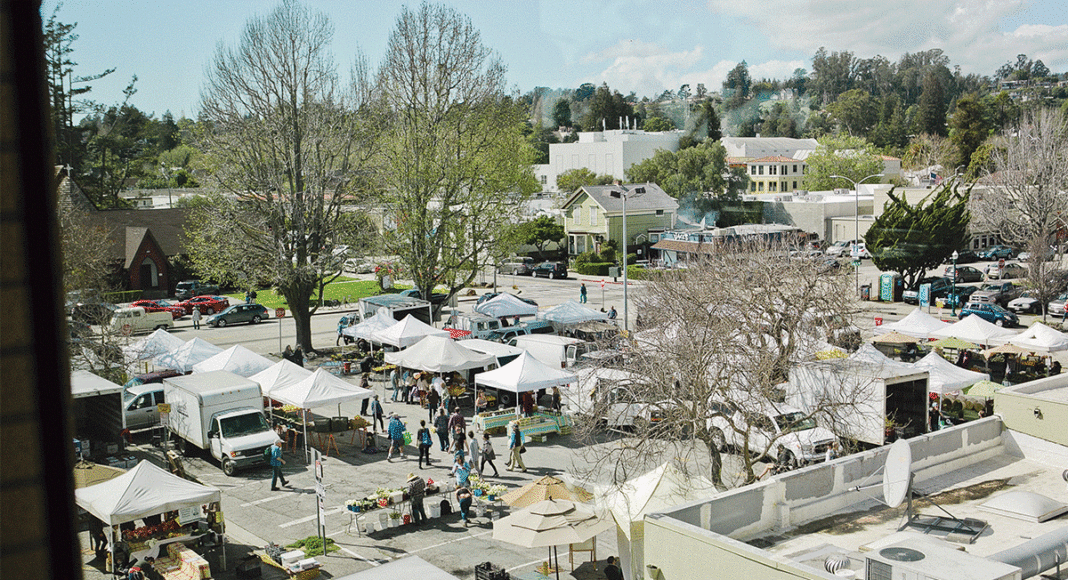As customers hunched over a wooden counter sip craft beers and ciders, Noelle Antolin, co-owner at Lúpulo, gazes out of the windows and across Cathcart Street, to where the sun plays on trees in the parking lot.
She and husband Stuyvie Bearns haven’t taken a stance on the parking structure—with a public library on the first floor—proposed for the lot across from their spot on Cathcart and Cedar streets. She admits that certain examples of parking garages that consultant firm Group 4 showed at a Santa Cruz City Council meeting in December were surprisingly artistic—some immersed in vines and greenery or bejeweled with a rainbow of bright pastel lights. Another was designed to resemble a row of classic novels, including Catch-22.
Antolin isn’t sure what to make of it all.
“It would change the dynamics of the street. We’re in the land of blue skies and old trees. But at the same time, it might bring more foot traffic,” says Antolin, who has been going to meetings to learn more about rough sketches for the possible garage. Others have stronger feelings about the possible 70-foot-tall structure.
“There are so many ways to travel now,” says Wade Hall, who owns Spokesman Bicycles next door to Lúpulo. “Electric bikes. Electric skateboards. Rail to trail. All these things are just coming online.” He insists that in a few decades, giant parking structures will look as outdated as an old barn does now.
So while the possible garage wends its way through the city process, some neighboring businesses have joined environmental activists in opposing the plan.
And although most downtown business leaders haven’t exactly been resistant to the idea, neither have they embraced it.
“Not enough business members are tuned in to this issue yet. People don’t know about it, and the people who do know haven’t decided yet,” says Santa Cruz Downtown Commissioner Robert Singleton, also a policy analyst for the Santa Cruz County Business Council.
With all of the money they already spend toward parking deficiency fees, some business owners are wary of a garage estimated to cost around $35 million, until they know where the money’s going to come from.
The Downtown Commission heard about the garage at its March 23 meeting, while looking at the city’s Capital Improvement Program (CIP). Transportation Manager Jim Burr suggested the commission give the City Council direction on how to spend CIP money, especially when it came to a possible $2.3 million allotment city staff would use to design the garage if the project moves forward. That’s a chunk of change the commission declined to either endorse or oppose for the council. Or, as Singleton put it, “It’s your bed, you have to make it.”
If the council stays the course, the combination parking structure and library would come back for more robust public hearings, with more notices going out to people who live and work nearby. By then, a downtown parking study will have come out, and the commission should have a better sense of how they would fund the garage, and the city manager’s office should have an idea of how to preserve the downtown farmers market, which currently calls that lot home. Library leaders, who are spending money from the June 2016 election, might then have a clearer sense of what their timeline is—as well as how well it lines up with the garage.
Singleton suggests this may also give the city more time to study the transportation demand alternatives that many activists are clamoring for.
The plan could also shift in shape or size, partly because Christophe Bellito, who owns Toadal Fitness, doesn’t want to run a gym in the shadow of a parking structure—especially one that would block his rooftop solar panels. He says he’s open to selling the parcel and moving somewhere nearby.
In explaining the demand for parking downtown, City Manager Martín Bernal has stressed that the city could lose parking in a couple lots, as two are sites for possible developments, including Owen Lawlor’s possible Lower Pacific Avenue housing project. Lawlor tells GT that once the city passes its Downtown Recovery Plan amendments, he’ll submit his plans.
A much larger parking lot belongs to the Calvary Episcopal Church. Its fate is difficult to pin down, but the parish has talked about putting housing there before, and it always listens to offers.
“Property owners are getting more and more pressure if you have a property that’s vacant or basically vacant,” says parishioner Scott Galloway, who serves on a church committee. “And I can safely say that a single-story parking lot isn’t the best use for the city.”
But even if the church does pick a project, Galloway says it would be at least a couple of years before it would break ground.
The church gets $80,000 per year from the city to lease the lot, Galloway says, which helps maintain their 157-year-old building. A housing project might provide a little more money, while also helping people in need, but developments like those often come with risk.
Calvary finds itself constantly weighing the desires of different parishioners, most of whom enjoy having a free place to park on Sundays.
Walking through the redwood church, Galloway points out the colorful, south-facing stained glass windows. Those could end up in the shade if the parish erected a towering apartment complex next door.
“We want those to have sun,” he says.
Update 4/5/2017 9:45a.m.: Hula’s Island Grill was incorrectly said to oppose the parking structure. The restaurant is still exploring how it feels about the project.














